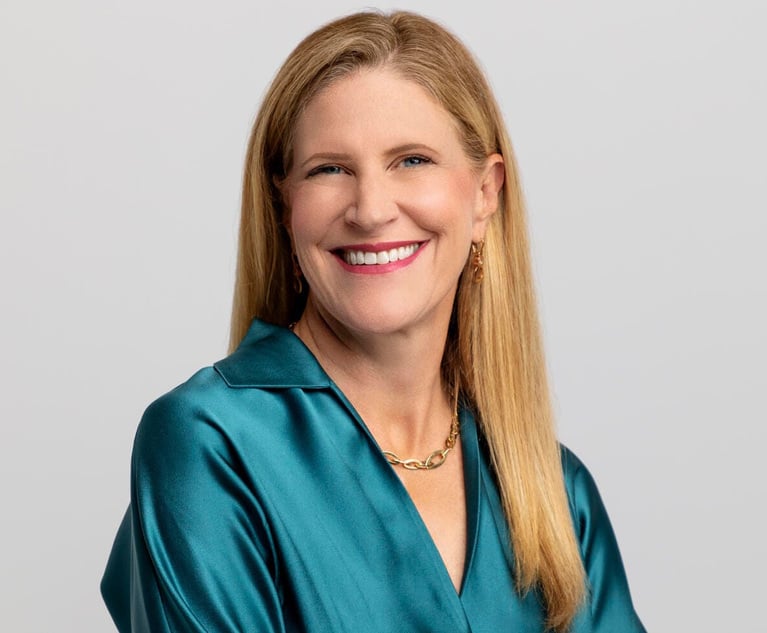As Technology Advances, People Remain Key to Successful Compliance
Technology will never replace strong teams and good culture, says Walmart's chief compliance officer.
September 04, 2018 at 07:00 AM
4 minute read

Whenever I interact with my peers in the legal community, I often get asked the same two questions related to Walmart: How do we manage the size of our company—2.3 million associates, over 260 million customer transactions per week and more than 11,700 stores—and how does technology help a company the size of Walmart to manage risk across 28 countries?
While technology is a key differentiator of our compliance program compared with other global companies, the bedrock of our program has always been strong leadership. In a word, our program works because of our culture. Good systems, design and processes are critical, but people are the foundation.
I can remember one of my first legal roles working in Argentina, 25 years ago, at one of the world's largest construction companies, what is now Salini Impregilo. The world and technology were different then—more local, less connected. Lawyers did not carry around smartphones (I did not even own a cellphone), and document management systems were for law firms, if anyone. One thing that isn't different is that I measured my success in my role by how much I could help the business while protecting the shareholders (just like I do today). I learned early in my career that, if I could find a way to save the business enough money to support my budget, that was a good first step toward a strong partnership and showing the business that, as a lawyer, I had the same focus on the business' success.
Now everything is digital. More than six years ago, I wrote an article for this magazine analogizing the saber metrics used in baseball to compliance and how data could help manage a compliance program. At the time, I worked at Schlumberger, a company obsessed with technology and innovation. At Schlumberger, we brought that same spirit to compliance. We allocated risk by looking at our data. Interactive maps replaced PowerPoint presentations. Technology helped us manage everything, from documents to our outside counsel. The “Moneyball” article talked about how to truly use data to create a risk-based program and drive compliance resource decisions. I remember, when we rewrote the code of conduct, we started with a story about what it meant to work at Schlumberger and to live the company's culture and values. The company understood that culture drives technology and innovation.
Today, technology provides key tools for in-house counsel and compliance professionals. Each day, we use data and technology to help manage our risk-based program just as the business leverages technology to empower associates and improve the customer experience. A risk map that 10 years ago provided a static risk picture with manual updates is now driven by data feeds and updated in real time. Bots empower us to move faster and more efficiently, assisting with tasks ranging from sorting help-line calls to scouring social media feeds. Technology helps our legal department leverage resources to manage outside counsel, litigation dockets and transactions.
When I think about how technology will impact compliance in the future, we are already starting to see an impact in some subject matters (e.g., privacy) as the regulatory environment evolves. Other areas, such as blockchain technology, may give rise to additional challenges and regulations. And while technology may help us move faster and more efficiently, it will never replace good judgment and a strong team. Dan Coyle wrote a book published earlier this year called “The Culture Code: The Secrets of Highly Successful Groups,” which analyzes how strong teams work together, whether it's the U.S. Navy SEALs or a leadership team in Silicon Valley. The book begins with a story about a competition to create a tower out of 20 pieces of uncooked spaghetti, a yard of transparent tape, a yard of string and a marshmallow. Coyle discusses how, using teamwork, a group of kindergarteners beat a team of business school students, lawyers and CEOs.
For me, the takeaway for tomorrow is a lesson of today: Technology can help you move faster and more efficiently and even enable better decisions with more information, but it will never replace strong teams and good culture. I spend more time thinking about how to build a strong team than finding the best system to use. As our world and regulatory environment change, we will continue to find new tools that will help us do our jobs more efficiently, but my most productive meetings still happen when I put my team together to hash out an issue.
Daniel Trujillo is the senior vice president and chief ethics and compliance officer for Walmart International. He may be reached at [email protected].
This content has been archived. It is available through our partners, LexisNexis® and Bloomberg Law.
To view this content, please continue to their sites.
Not a Lexis Subscriber?
Subscribe Now
Not a Bloomberg Law Subscriber?
Subscribe Now
NOT FOR REPRINT
© 2025 ALM Global, LLC, All Rights Reserved. Request academic re-use from www.copyright.com. All other uses, submit a request to [email protected]. For more information visit Asset & Logo Licensing.
You Might Like
View All
Tesla, Musk Appeal Chancery Compensation Case to Delaware Supreme Court
2 minute read
Former Capital One Deputy GC Takes Legal Reins of AIG Spinoff

Khan Defends FTC Tenure, Does Not Address Post-Inauguration Plans
Trending Stories
- 1Dispute Resolution Boards—Getting Real Time Decisions on Construction Projects
- 2Commonwealth Court Overturns Award of Damages Assessed Against Landlord on Claims of Unlawful Discrimination
- 3NY Top Court to Decide Whether County Governments Owe Special Duty to Foster Care Placements
- 4Tesla, Musk Appeal Chancery Compensation Case to Delaware Supreme Court
- 5Some New Twists and Old Tricks for an Ethical New Year
Who Got The Work
Michael G. Bongiorno, Andrew Scott Dulberg and Elizabeth E. Driscoll from Wilmer Cutler Pickering Hale and Dorr have stepped in to represent Symbotic Inc., an A.I.-enabled technology platform that focuses on increasing supply chain efficiency, and other defendants in a pending shareholder derivative lawsuit. The case, filed Oct. 2 in Massachusetts District Court by the Brown Law Firm on behalf of Stephen Austen, accuses certain officers and directors of misleading investors in regard to Symbotic's potential for margin growth by failing to disclose that the company was not equipped to timely deploy its systems or manage expenses through project delays. The case, assigned to U.S. District Judge Nathaniel M. Gorton, is 1:24-cv-12522, Austen v. Cohen et al.
Who Got The Work
Edmund Polubinski and Marie Killmond of Davis Polk & Wardwell have entered appearances for data platform software development company MongoDB and other defendants in a pending shareholder derivative lawsuit. The action, filed Oct. 7 in New York Southern District Court by the Brown Law Firm, accuses the company's directors and/or officers of falsely expressing confidence in the company’s restructuring of its sales incentive plan and downplaying the severity of decreases in its upfront commitments. The case is 1:24-cv-07594, Roy v. Ittycheria et al.
Who Got The Work
Amy O. Bruchs and Kurt F. Ellison of Michael Best & Friedrich have entered appearances for Epic Systems Corp. in a pending employment discrimination lawsuit. The suit was filed Sept. 7 in Wisconsin Western District Court by Levine Eisberner LLC and Siri & Glimstad on behalf of a project manager who claims that he was wrongfully terminated after applying for a religious exemption to the defendant's COVID-19 vaccine mandate. The case, assigned to U.S. Magistrate Judge Anita Marie Boor, is 3:24-cv-00630, Secker, Nathan v. Epic Systems Corporation.
Who Got The Work
David X. Sullivan, Thomas J. Finn and Gregory A. Hall from McCarter & English have entered appearances for Sunrun Installation Services in a pending civil rights lawsuit. The complaint was filed Sept. 4 in Connecticut District Court by attorney Robert M. Berke on behalf of former employee George Edward Steins, who was arrested and charged with employing an unregistered home improvement salesperson. The complaint alleges that had Sunrun informed the Connecticut Department of Consumer Protection that the plaintiff's employment had ended in 2017 and that he no longer held Sunrun's home improvement contractor license, he would not have been hit with charges, which were dismissed in May 2024. The case, assigned to U.S. District Judge Jeffrey A. Meyer, is 3:24-cv-01423, Steins v. Sunrun, Inc. et al.
Who Got The Work
Greenberg Traurig shareholder Joshua L. Raskin has entered an appearance for boohoo.com UK Ltd. in a pending patent infringement lawsuit. The suit, filed Sept. 3 in Texas Eastern District Court by Rozier Hardt McDonough on behalf of Alto Dynamics, asserts five patents related to an online shopping platform. The case, assigned to U.S. District Judge Rodney Gilstrap, is 2:24-cv-00719, Alto Dynamics, LLC v. boohoo.com UK Limited.
Featured Firms
Law Offices of Gary Martin Hays & Associates, P.C.
(470) 294-1674
Law Offices of Mark E. Salomone
(857) 444-6468
Smith & Hassler
(713) 739-1250







